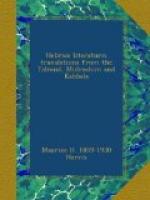Ibid., fol. 71, col. 2.
He who sets aside a portion of his wealth for the relief of the poor will be delivered from the judgment of hell. Of this the parable of the two sheep that attempted to ford a river is an illustration; one was shorn of its wool and the other not; the former, therefore, managed to get over, but the latter, being heavy-laden, sank.
Gittin, fol. 7, col. 1.
Zoreah and Eshtaol (Josh. xv. 33) were two large mountains, but Samson tore them up and grated the one against the other.
Soteh, fol. 9, col. 2.
The above tradition is founded on Judges xiii. 25, in which it is said of Samson, “And the spirit of God began to move him at times in the camp of Dan, between Zoreah and Eshtaol,” in which the word “move,” signifies also to “strike a stroke,” “step a step,” and “once.” Founding on which last two meanings, Rabbi Yehudah says, “Samson strode in one stride from Zoreah to Eshtaol,” a giant stride of two miles or more. Taking the word in the sense of “strike,” or “producing a ringing sound,” another Rabbi tells us that the hairs of Samson’s head stood upright, tinkling one against another like bells, the jingle of which might be heard from Zoreah to Eshtaol. The version in the text takes the same word in the sense of to “strike together.”
On the day when Isaac was weaned, Abraham made a great feast, to which he invited all the people of the land. Not all of those who came to enjoy the feast believed in the alleged occasion of its celebration, for some said contemptuously, “This old couple have adopted a foundling, and provided a feast to persuade us to believe that the child is their own offspring.” What did Abraham do? He invited all the great men of the day, and Sarah invited their wives, who brought their infants, but not their nurses, along with them. On this occasion Sarah’s breasts became like two fountains, for she supplied, of her own body, nourishment to all the children. Still some were unconvinced, and said, “Shall a child be born to one that is a hundred years old, and shall Sarah, who is ninety years old, bear?” (Gen. xvii. 17.) Whereupon, to silence this objection, Isaac’s face was changed, so that it became the very picture of Abraham’s; then one and all exclaimed, “Abraham begat Isaac.”
Bara Metzia, fol. 87, col. 1.
Rava relates the following in the name of Rabbi Yochanan:—“Two Jewish slaves were one day walking along, when their master, who was following, overheard the one saying to the other, ’There is a camel ahead of us, as I judge—for I have not seen—that is blind of one eye and laden with two skin-bottles, one of which contains wine and the other oil, while two drivers attend it, one of them an Israelite, and the other a Gentile.’ ‘You perverse men,’ said their master, ’how can you fabricate such a story as that?’ The slave answered, and gave this as his reason, ’The grass is cropped




